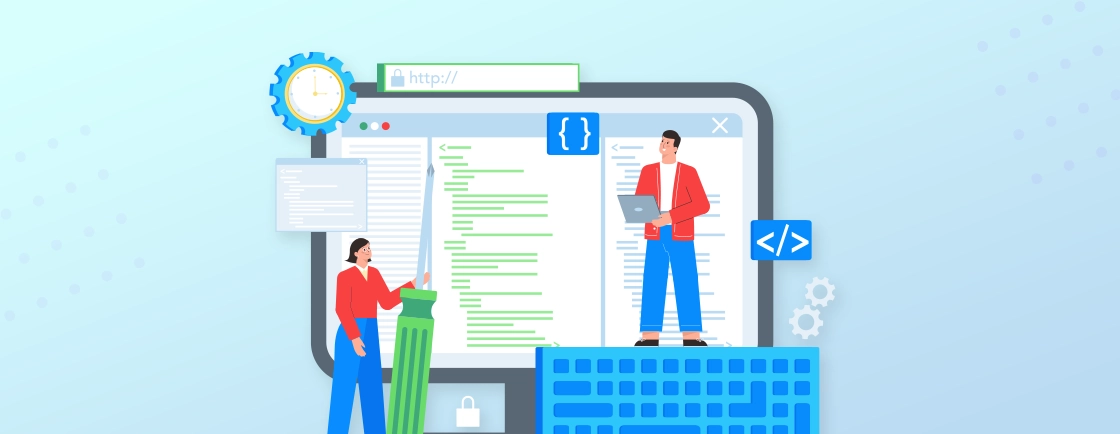Table of Contents
Progressive Web Apps (PWAs) represent a pivotal convergence of web and mobile technologies, providing a compelling solution for the digital age. These innovative applications offer users a unique and seamless experience, combining the best of both web and mobile app worlds.
In a rapidly evolving digital landscape, where accessibility, engagement, and performance are paramount, PWAs have emerged as a powerful tool for businesses and developers seeking to meet the growing demands of their audience.
In this article, we’ll explore what PWAs are, dive into their key features, highlight the numerous benefits they bring to the table, showcase some inspiring examples, and address common questions to help you understand why PWAs are a transformative force in the realm of digital experiences.
What are Progressive Web Apps?
Progressive Web Apps (PWAs) stand at the forefront of modern web application development processes, combining the flexibility of web technologies with the immersive user experience of native mobile applications.
They are a breakthrough in the digital sphere, providing users with the advantages of both web and mobile applications without the need for installation from an app store. PWAs are designed to function on any device or browser while offering a rich, app-like experience.
- Enhanced User Experience: PWAs are built to offer a seamless, app-like experience with smooth navigation, engaging animations, and an intuitive interface, mirroring the best aspects of native mobile apps.
- Cross-platform Compatibility: These applications are designed to work flawlessly on various devices and operating systems, ensuring a consistent experience across platforms without the need for separate codebases.
- Offline Functionality: PWAs have the ability to operate even in offline or low-connectivity scenarios, providing users access to certain features or cached content, thereby ensuring uninterrupted usage.
- Fast Loading and Performance: They are engineered for speed, loading instantly and delivering smooth performance, even on slower networks, contributing to improved user engagement and retention.
- Discoverability and Accessibility: Unlike traditional mobile apps, PWAs can be discovered through search engines, making them easily accessible to users without the need for installation from an app store. This facilitates a wider reach and simpler user acquisition.
Progressive Web Apps (PWAs) represent a pivotal fusion of web and mobile technologies, offering an immersive user experience while simplifying development.
For businesses seeking tailored web app solutions, consulting with an experienced web development company with a proven track record can be the initial strategic step. Leveraging their expertise can ensure the creation of PWAs that align with specific business needs, enhancing user experiences and meeting overarching business objectives.
Key Features of Progressive Web Apps
Progressive Web Apps (PWAs) are a groundbreaking solution that merges the best of web and mobile applications. Their key features are tailored to offer an app-like experience while leveraging the reach and flexibility of web technologies. Below are seven vital characteristics that define and distinguish PWAs in the digital landscape.
1. Responsiveness
Progressive Web Apps (PWAs) excel in responsiveness, dynamically adjusting and adapting to various devices and screen sizes. This adaptability ensures a uniform and optimal user experience, regardless of the platform used.
By avoiding web design mistakes, PWAs streamline the user interface, providing a consistent look and feel across desktops, tablets, and smartphones. This not only simplifies development by negating the need for multiple versions but also significantly enhances user satisfaction and engagement.
The ability to seamlessly respond to different device specifications is a fundamental characteristic that sets PWAs apart, offering a unified experience to users across diverse platforms.
2. Connectivity Independence
Connectivity independence is a core feature of PWAs, enabling them to function seamlessly even in offline or low-connectivity scenarios. Through the utilization of service workers and smart caching strategies, PWAs ensure that essential resources are stored locally.
This empowers users to access certain features or content without an active internet connection. This functionality is crucial in areas with unreliable or limited network access, ensuring continued user engagement and usability.
By providing an offline-capable experience, PWAs demonstrate resilience and reliability, distinguishing themselves from traditional web applications or even some native apps.
3. App-like Experience
PWAs offer an immersive and app-like experience to users, akin to native mobile applications. They provide smooth navigation, engaging animations, and an intuitive user interface.
This results in an interactive and engaging environment that keeps users involved and connected. By leveraging the latest web capabilities, PWAs ensure an experience that mirrors the best aspects of native apps, fostering increased user engagement and satisfaction.
This app-like feel, coupled with the convenience of being easily accessible via a browser, contributes to the widespread popularity and success of PWAs in the digital landscape.
4. Fast Loading and Performance
PWAs are optimized for speed, offering quick loading times and superior performance, even on slower networks. By employing various performance optimization techniques such as caching strategies, pre-fetching, and minimizing unnecessary data usage, PWAs ensure a snappy user experience.
Their ability to load swiftly contributes to increased user engagement and retention. Furthermore, their efficient performance helps in reducing bounce rates and retaining user interest, making them an appealing choice for both users and businesses seeking high-performing applications.
5. Secure
Security is a cornerstone of Progressive Web Apps, as they operate under HTTPS to ensure data integrity and user safety. This HTTPS protocol safeguards against potential security threats and unauthorized access, fostering user trust and confidence.
This commitment to security reassures users about the safety of their data and interactions with the application. It’s an essential feature that distinguishes PWAs, aligning them with best practices for safeguarding user information and contributing to a positive user experience.
6. Discoverability and Accessibility
PWAs stand out for their ease of discovery and accessibility. Unlike traditional mobile apps, they are easily discoverable through search engines, enhancing their reach and visibility.
This accessibility facilitates user acquisition without the need for installation from an app store, making them more widely available to potential users. This characteristic not only simplifies the process of accessing the application but also broadens its user base, contributing to increased adoption and usage.
7. Automatic Updates
PWAs feature automatic updating, ensuring that users always have access to the latest version without manual interventions. These updates occur in the background, guaranteeing that the app remains current with the latest features and security patches.
This seamless and automatic updating process keeps the application fresh and secure, ensuring that users are constantly benefiting from the most up-to-date version without any inconvenience or effort on their part. This feature contributes to user satisfaction and the overall success of PWAs in the digital ecosystem.
These features collectively position PWAs as a versatile and powerful solution in the world of digital applications. Their ability to deliver a consistent, fast, and engaging user experience across various platforms, makes PWAs a strategic choice for businesses seeking to expand their digital presence.
Embracing these characteristics not only ensures a broader user reach but also contributes to increased user satisfaction and loyalty, establishing PWAs as a transformative force in the digital landscape.
Benefits of Progressive Web Apps
Progressive Web Apps (PWAs) offer a multitude of advantages that cater to both users and businesses. Their unique characteristics bridge the gap between web and native applications, providing an array of benefits that enhance user experience and streamline development. Below are key benefits that distinguish PWAs in the digital landscape.
1. Enhanced User Experience
PWAs deliver an immersive and responsive user experience, offering seamless navigation and a fast-loading interface. Their app-like feel and adaptability across various devices ensure a consistent and engaging experience for users. This leads to increased user satisfaction and extended session durations.
2. Wider Reach and Accessibility
These applications are easily discoverable via search engines, eliminating the need for installation from an app store. This simplifies access, making PWAs more widely available to users. They can be shared via URLs and accessed across different platforms, expanding their reach.
3. Improved Performance
PWAs are designed for speed and efficiency, loading quickly even in low-connectivity scenarios. This fast-loading capability contributes to reduced bounce rates and increased user retention, crucial for businesses aiming to keep users engaged.
4. Cost-Effectiveness for Businesses
For businesses, PWAs present a cost-effective solution. They eliminate the need for separate development of multiple versions for different platforms, streamlining maintenance and development costs. Their adaptability across devices reduces overall development expenses.
5. Offline Functionality and Reliability
PWAs can function offline or in poor network conditions, ensuring continuity and reliability. Users can access certain features or content even without an active internet connection. This feature is invaluable in retaining user engagement, especially in areas with limited connectivity.
In conclusion, Progressive Web Apps offer a diverse range of benefits that cater to the needs of both users and businesses. Their ability to enhance user experience, widen accessibility, and improve performance, coupled with cost-effectiveness and offline functionality, positions PWAs as a strategic choice in the digital landscape.
Embracing these benefits not only augments user satisfaction but also contributes to achieving business objectives, making PWAs a compelling and influential force in the realm of digital applications.
Examples of Progressive Web Apps
Progressive Web Apps (PWAs) have gained prominence across various industries, offering innovative solutions that combine the best features of web and mobile applications. Here are some notable examples that exemplify the diverse applications and advantages of PWAs in different domains.
1. Twitter Lite
Twitter Lite is a prime example of a successful PWA, offering a fast and lightweight version of the social media platform. It provides an engaging and seamless user experience, even on slow networks. Twitter Lite is highly optimized for speed and performance, significantly reducing data usage and load times, making it a favored choice for users in regions with limited connectivity.
2. Starbucks
The Starbucks PWA is an exemplary implementation in the retail sector. It delivers a user-friendly experience, enabling customers to order, customize, and pay for their favorite beverages and food. This PWA ensures a consistent and convenient experience across various devices, with offline capabilities for ordering, even in areas with poor connectivity.
3. Flipkart
Flipkart, a leading e-commerce platform in India, leveraged PWA technology to offer an app-like experience to its users. The Flipkart PWA boasts quick load times, smooth navigation, and an engaging interface, resembling a native app. It caters to users with limited storage space on their devices while delivering an immersive shopping experience.
These examples showcase the versatility and applicability of PWAs across diverse industries. From social media platforms like Twitter to retail giants such as Starbucks and e-commerce leaders like Flipkart, PWAs have revolutionized the digital experience for users.
Their seamless functionality, quick load times, and adaptability across devices make PWAs an attractive and practical choice for businesses aiming to enhance user engagement and accessibility. As more companies adopt this technology, PWAs continue to demonstrate their value and impact in the evolving landscape of digital applications.
Conclusion
In conclusion, Progressive Web Apps (PWAs) have emerged as a pivotal bridge between traditional web and native mobile applications. Their ability to offer an immersive user experience, high performance, and cross-device functionality while maintaining web accessibility sets them apart in the digital landscape.
The synergy of features such as responsiveness, offline capabilities, and automatic updates contributes to a seamless and engaging user journey, meeting the evolving demands of the modern digital era. The showcased examples, combined with a breakdown of key features, benefits, and FAQs, highlight the diverse applications and advantages of PWAs. If you need any further assistance or wish to embark on professional web app development under expert guidance, get in touch with us today. Let our team cover all your development needs and bring your vision to reality.
FAQs About Progressive Web Apps
What is the difference between PWA and web app?
Web App:
– A traditional web app refers to any application accessed through a web browser, designed for use on a desktop or mobile device.
– It relies on responsive design to adapt to various screen sizes but might not offer features typically associated with native apps, such as offline access or push notifications.
Progressive Web App (PWA):
– A PWA is an enhanced type of web app that leverages modern web capabilities to offer a more app-like experience.
– Unlike conventional web apps, PWAs provide features like offline functionality, push notifications, and the ability to be added to the home screen, blurring the line between web and native applications.
Is PWA a backend?
No, PWA is not a backend
– A PWA is a type of application that uses web technologies to offer an app-like experience on the front end, leveraging modern web capabilities.
– The backend for a PWA typically involves a server and a database, just like traditional web applications, to manage data, perform business logic, and handle requests made by the PWA.
What language is PWA written in?
PWA is written in standard web technologies: HTML, CSS, and JavaScript.
– These are the core languages used for creating the frontend of PWAs, allowing for the design, layout, and interactivity of the application.
– Additionally, service workers, a key component of PWAs enabling offline functionality, are written in JavaScript to manage network requests and caching strategies.
Explore Our Expert Guides
Dive into detailed tutorials, tips, and strategies designed to help you grow, innovate, and solve problems efficiently.





